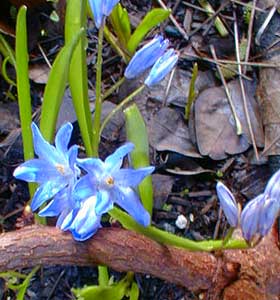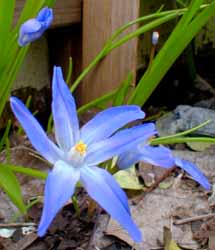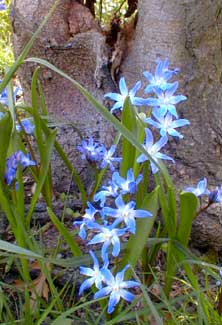
Natural Blue
Glory-of-the-Snow
"List, the winds of March are blowing;
Her ground-flowers shrink, afraid of showing
Their meek heads to the nipping air."
-William Wordsworth
(1770-1850)
(1770-1850)
There is some taxonomic confusion over Glory-of-the-Snow's scientific name. It was formerly called Chionodoxa luciliae after Lucille Bossier, the wife of a Swiss botanist, but it is now called C. forbesii, of which there are three varieties on the market: 1) the wild normal form that is blue with a white to yellowish heart; 2)C. forbesii var. alba or 'Alba' which is a natural white form, & 3) a cultivar with pink flowers, C. forbesii 'Pink Giant.' These are all now reassigned as the species C. forbesii, though catalogs & packagers persist in using both names interchangeably.
One of the even older banished names C. gigantea still turns up on nursery labels or in bulb catalogs. To further confuse matters, there is is a gentian blue variety sometimes listed as entirely the wrong species; these are actually C. sardensis.
 Glory-of-the-Snow is so-named because in some climates it blooms early enough that it pokes its little bright blue six-petalled flowers right out of the snow. We have the normal blue variety shown in first two March photos, for 2003 & 2004 respectively. The little patch of the blue grows at the foot of an akebia arbor.
Glory-of-the-Snow is so-named because in some climates it blooms early enough that it pokes its little bright blue six-petalled flowers right out of the snow. We have the normal blue variety shown in first two March photos, for 2003 & 2004 respectively. The little patch of the blue grows at the foot of an akebia arbor. More than two-dozen additional bulbs were added mid-autumn 2003 right in the lawn-turf on the morning-sun side in front of the chokecherry tree, as chionodoxa similar to crocuses can naturalize in grass. This patch buds out in March but is not in full flower until April. These are shown in the third photo. The second patch has done hugely better because it gets more sun.
The other variety that we have is 'Pink Giant,' a recipient of the "Outstanding Plant Award" by the Royal General Bulbgrower's Association in Holland. This small drift is at the foot of a Redtwig Dogwood. That patch has been rather floppy & unappealing for two bloom-seasons, because the area is much too shady for it. If they're ever to do well, I will have to lift the bulbs to place them in better sun.
 Chiodonodoxa is closely related to, & formerly categorized as a Scilla. Like Scilla, it is supposed to do in partial shade to partial sun or full sun, & can take soils either dry or moist. But the two patches we placed where they get only a little afternoon sun, though blooming fine, are so weak-stemmed & floppy-leafed with tepid flowering, they might actually qualify as ugly. Only the morning-sun patch of blues is beautiful. So on Puget Sound at least, they need more sun. Inland or further south, the generality that they also do well in partial shade might be truer than it is here.
Chiodonodoxa is closely related to, & formerly categorized as a Scilla. Like Scilla, it is supposed to do in partial shade to partial sun or full sun, & can take soils either dry or moist. But the two patches we placed where they get only a little afternoon sun, though blooming fine, are so weak-stemmed & floppy-leafed with tepid flowering, they might actually qualify as ugly. Only the morning-sun patch of blues is beautiful. So on Puget Sound at least, they need more sun. Inland or further south, the generality that they also do well in partial shade might be truer than it is here.It can sometimes spread aggressively, & certainly naturalizes well, especially if it is not deadheaded but is permitted to go to seed. It will even do well under walnut trees, being unaffected by walnuts' growth-retarding juglone such as often causes the area under a walnut to be void of plantlife.
These natives of western Turkey were first described in 1877. They are suitable for zones 3-8. Here in Zone 8 they begin blooming mid-March, having first produced two or three slender basal leaves per bulb, with a single flower stalk no taller than about six or eight inches.
Some people treat them like crocuses & plant them in a lawn, wherever there will be no feet tramping. If the mower's blade is set just a bit high, chionodoxa leaves are small enough that they can be missed when it is time to mow the lawn, by which time the Chionodox will be done blooming. Obviously, as with crocuses, they will do better if not competing with sod, but it's a nice planting option to consider.
The bulbs are planted three inches apart, two to four inches deep, in autumn. I remember we got our first bulbs in winter rather than autumn, as they had gone on sale for next to nothing, & we hand-selected each bulb so as to avoid those which had gotten soft or moldy. They seemed to do fine despite not getting into the ground until January, though I would not recommend them so late unless you too see them offered for practically nothing. The later ones we added were also on sale but we got them in the ground early in November which is never a problem.
The natural Blue is on average in fuller bloom a week earlier than the Pink cultivar. I like the Blue best, as it has a glassy transluscence. The Pink is really more of a rose-violet, with white center, & despite being called Pink Giant the flower is a little smaller than the blue.
Not only do they naturalize with great ease, but a single mature corm can produce as many as ten flowers. The strappy leaves form untidy rosettes that die into dormancy come summer.